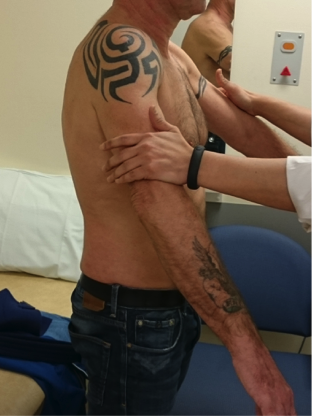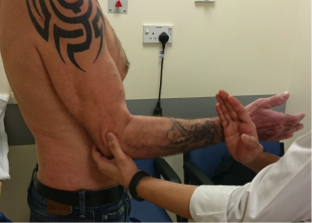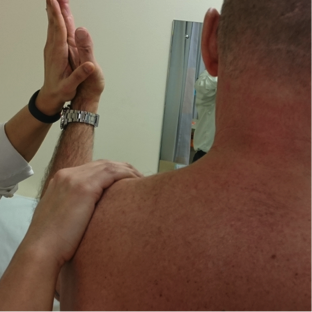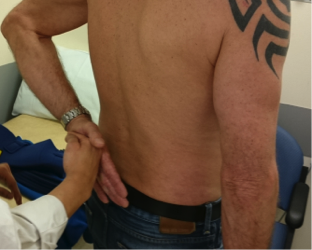Rotator Cuff Assessment
The rotator cuff muscles should be tested in sequence followed by deltoid & other muscles of shoulder girdle.
Supraspinatus
- This is an abductor of the shoulder. Deltoid also assists in abduction of the shoulder and is more powerful than supraspinatus.
Jobe’s ‘Empty Can’ Test
The shoulder is abducted to 90°in the scapular plane (30°forward flexion). The arm is internally rotated and forearm pronated so that the thumb points the ground. Push down and ask patient to resist. Feel the muscle.

Figure 31.Demonstration of Jobe’s test (Performed from front)

Figure 32.Demonstration of Jobe’s test (Performed from side) The muscle is felt.
Infraspinatus and Teres Minor
Infraspinatus is the most powerful external rotator of the shoulder when the arm is by the side.
Testing Infraspinatus
- Elbow on the side and flexed at 90°. Ask the patient to externally rotate and resist this movement. Feel the muscle.
External Rotation Lag Sign
- Elbow on the side and flexed at 90°. The shoulder is placed passively in full external rotation and patient asked to maintain this position. The hand holding the arm is released. The test is positive if the forearm drops back towards neutral position. (Infraspinatus tear)

Figure 33.Testing External rotation in adduction (Infraspinatus, Performed from front)

Figure 34.Testing External rotation in adduction.(Infraspinatus, Performed from side) The muscle is felt.
Teres Minor
Teres minor assists infraspinatus in external rotation. Teres minor can be isolated by abduction of shoulder to 90°and testing external rotation.
Testing for Teres Minor
- Hornblowers Sign-Shoulder abducted to 90°, elbow flexed to 90°and shoulder externally rotated. Patient can maintain this position even against some resistance. Inability to maintain this position results in results in hand falling in front of the face with further elbow flexion.

Figure 35.Testing External rotation in abduction (Teres Minor isolated)
Subscapularis
It is a powerful internal rotator of the shoulder and forms the force couple with infraspinatus.
Gerber’s Lift off Test
- The arm is placed behind the back and the hand is positioned away from the body. Inability to maintain this position indicates muscle weakness.
- Limitation - Patients with restricted internal rotation may struggle to get their hand behind their back.

Figure 36.Demonstration of Gerber’s Lift Off Test
Belly Press Test
- The elbow is kept forward and the patient is asked to press their hand into their abdomen.
- This is an alternate test for subscapularis if shoulder movements are restricted.

Figure 37. Demonstration of Belly Press test.